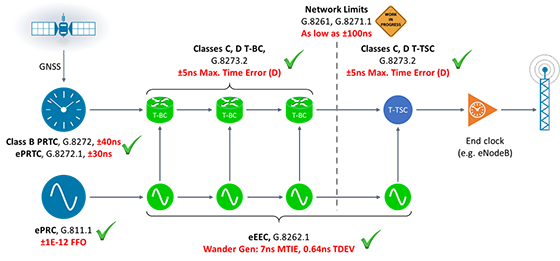The roll-out of 5G is on the horizon and for the Network Equipment Manufacturers responsible for developing, verifying and manufacturing devices against enhanced timing standards such as for ITU-T G.8273.2 Class-C/D Boundary clocks, getting performance verification is a challenge. How can NEM’s outperform the 5G Transport Accuracy Performance Challenge?
Many Network Operators are requiring NEM’s to pass a series of proof of concept events regarding the levels of synchronisation accuracy and speed of data transfer required to deliver end-user performance to get on future tender lists.
What is the target for accuracy?
The ITU’s standards for 5G are aimed at delivering time and phase to meet new transmission requirements, at levels of precision an order of magnitude beyond previous generations. In 5G networks the number of distributed small cells and remote radio units is expected to be much higher to deliver the traffic capacity and density levels forecasted. It is expected that co-operative radio techniques will be deployed to deliver the high data rates required, such as Co-ordinated Multipoint (CoMP) and inter-site Carrier Aggregation (CA). These techniques will require the participating small cells and radio units to be synchronised very accurately and depending on the technique, this could require an accuracy of better than 130ns.
What are the clock specs?

To achieve this very high level of accuracy, the full timing support method is used, with PTP and SyncE support in every switch and/or router along the synchronisation path. A range of new clock specifications have also been developed to improve the synchronisation accuracy at the end node. For example, class C and class D boundary clocks have been added to G.8273.2, along with an enhanced EEC specification (G.8262.1). Similarly, there is a new enhanced PRTC specification (G.8272.1), and Class B PRTC specification (G.8272) which has also been defined. And in addition to these new standards there are also associated network limits which will need to be met.
How can NEM’s gain assurance on performance? High precision synchronisation testing.
Carrying out high synchronisation PTP and SyncE testing at speeds of up to 100GbE with Paragon-neo will provide NEM’s with confidence in their equipment prior to Network Operator proof of concept tests and network deployment.
Testing with Paragon-neo enables:
Analysis of PTP conformance to standards based or user-defined profiles, with automatic indication of pass/fail (and reason for non-compliance) and report generation.
Generate SyncE wander and jitter for ITU-T G.8262.1/G.8262 testing, simultaneously measure SyncE wander and PTP Time Error, and control ESMC message generation for testing ITU-T G.8624.
Emulate PTP Master and Slave clocks to maximise accuracy and repeatability of PTP test, including specific test modes for various DUTs and automatic test selection for ITU-T standards conformance. Carrying out high precision synchronisation testing can reduce performance risk and provide confidence to NEM’s that their next generation equipment is providing next generation accuracy.
Carrying out high precision synchronisation testing can reduce performance risk and provide confidence to NEM’s that their next generation equipment is providing next generation accuracy.